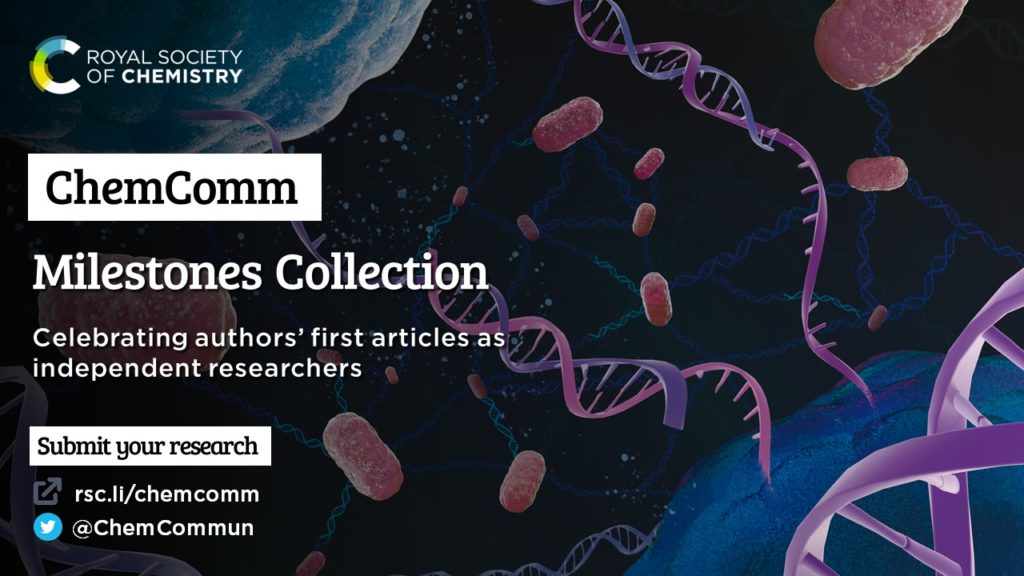We are excited to share the success of Marcin Lindner’s first-time independent article in ChemComm; “V-shaped donor–acceptor organic emitters. A new approach towards efficient TADF OLED devices” included in the full milestones collection.
Read our interview with Marcin below.
What are the main areas of research in your lab and what motivated you to take this direction?
Research in my group has focused on the rational design and the synthesis of functional aromatic materials such as concave N-doped polycyclic aromatic hydrocarbons (N-PAHs), curved heteroatom-doped nanographenes, donor-acceptor organic emitters with unique topology. These are investigated as emissive components in thermally activated delay fluorescent (TADF)/hyperfluorescent (HF) OLED devices, and hole-transporting layers (HTL) applied for more efficient throughput of Perovskite Solar Cells (PSCs). We have faced the challenge in constructing highly emissive organic materials by integrating donor-acceptor structure thoroughly fused and conjugated scaffold which bears, however, nonplanar geometry. We believe that implementation of such conceptually new, tailor-made organic materials would allow to holistically tune the desired optical properties such an efficient quantum yield, excited states energy difference, and bandgap energy.
Can you set this article in a wider context?
Seeking new organic emitters for TADF OLED devices has recently constituted an intensive field of research. Particularly, organic dyes with a small energy gap (ΔEST) which enable an efficient up-conversion process of triplet excitones are of high interest. The most common approach offered so far has relied on a use of rigid platforms decorated with twisted electron rich substituents to minimize HOMO-LUMO overlap which usually affects on ΔEST . We recently demonstrated first ambipolar and curved N-doped PAHs in which antiaromatic 7-memered ring led to the spatially separate HOMO-LUMO levels while curvature enabled one to minimize their overlap and achieve TADF emission (Angew. Chem. 2022, 61, e202202232) with PLQY up to 86% and EQE of 12%.
Building on that we envisaged the release of the structural tension from our pristine N-PAHs would result in the system bearing V-shaped topology leading to a well decoupled donor-acceptor system. In this published paper, we showed the rational design and concise synthesis of a new set of V-shaped D-π-A organic emitters. “Releasing structural tension” from our parental architecture, we gained access to a novel class of dyes with V-shaped geometry, which was transparently proved by X-ray single crystal analysis. Furthermore, HOMO-LUMO levels were well separated leading to the remarkable decrease of ΔEST (<0.1eV for each derivative) and efficacious TADF process. For the best performing phenoxazine decorated dye, we found appreciable PLQY of 36% accompanied by a very good EQE of 13.6% which indeed stress the importance of the efficient up-conversion of triplet excitones due to the low ΔEST energy. These demonstrated results shed light on new structural paradigm that contributes strongly to the increase of TADF OLED effciency.
What do you hope your lab can achieve in the coming year?
We have currently aimed at developing a peripheral functionalization of our N-PAHs. Moreover, we have explored the synthetic methodologies toward curved nanographenes which are going to be brought to light this year.
Describe your journey to becoming an independent researcher.
After my PhD in the group of Prof. Marcel Mayor (University of Basel, KIT Karlsruhe), I returned to Poland (2017) where I spent a short period of time at the industry (Selvita). With this valuable experience in a hand, I subsequently moved to Warsaw (IOC PAS). Within next 1.5 year I had here tackled to the development of new anion receptors and catalytic methods for stereo-selective semi-hydrogenation of alkynes, working in a group of Prof. Janusz Jurczak and Karol Grela, respectively. Meantime (2018/2019) I successfully applied for my first independent research grant (within the frame of Sonata 14 competition) funded by National Centre of Science. Year after (2020) I received second grant, this time from the National Centre of Research and Development (Lider XI). Within the scope of my independent research I try to perform a unique approach to the synthesis of aromatic compounds with goal of reaching a specific functionality.
What is the best piece of advice you have ever been give?
Well, here I would come with two quotes. Namely, “treat other as you want to be treated” and “make people believe what you believe in”. Both help me on daily basis to gradually become a better leader.
Why did you choose to publish in ChemComm?
ChemComm is a journal with a long tradition and an excellent reputation in chemistry. As it is a so-called “general” type of journal, it is accessed by the broad society of researchers who often cross the borders of chemistry and physics. “Publish your results in a journal, you used to read”. This attitude of my former co-advisor Dr Michal Valášek, (KIT, Germany) which was transferred to my professional life and was a driving force to publish following manuscript in ChemComm.
 |
Marcin Lindner completed his PhD in 2016 at the University of Basel, Switzerland, under the guidance of Prof. Marcel Mayor. He defended a PhD dissertation entitled “Tailor-made tetraphenylmethanes : from surface decoartion to 3D organic polymers”.
In 2017 he returned to Poland to work at Selvita as a Synthesis Specialist III. After this short adventure in industry he returned to academia (Institute of Organic Chemistry, Polish Academy of Science) to work with Prof. Janusz Jurczak (10/2017-01/2019) and Prof. Karol Grela (02-11/2019). Since 2019, has been employed as assistant professor and appointed a head of the Aromatic Functional Materials group at the IOC, PAS in Warsaw. Twitter: @lindner_marcin |
Explore more ChemComm Milestones news and updates on our Twitter: @ChemCommun






















